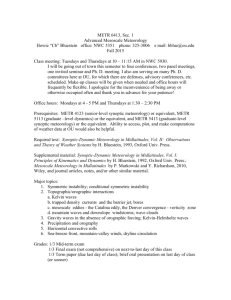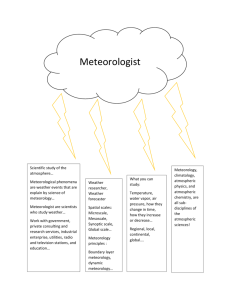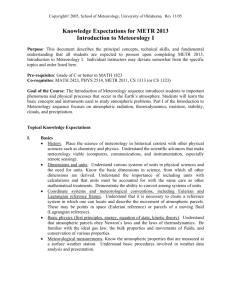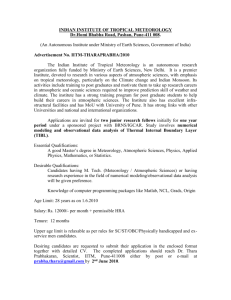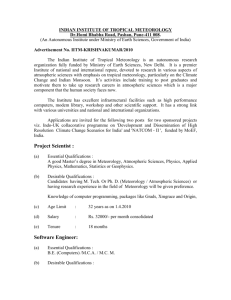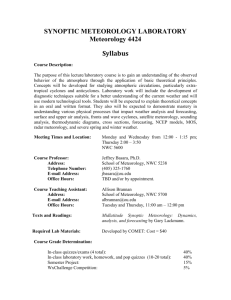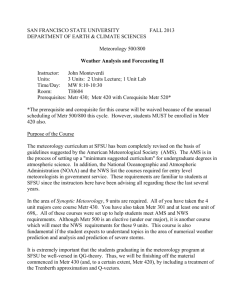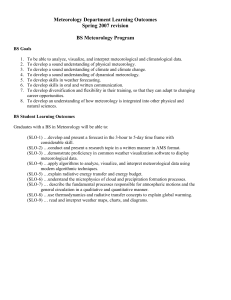Knowledge Expectations for METR 2023 Introduction to Meteorology II
advertisement
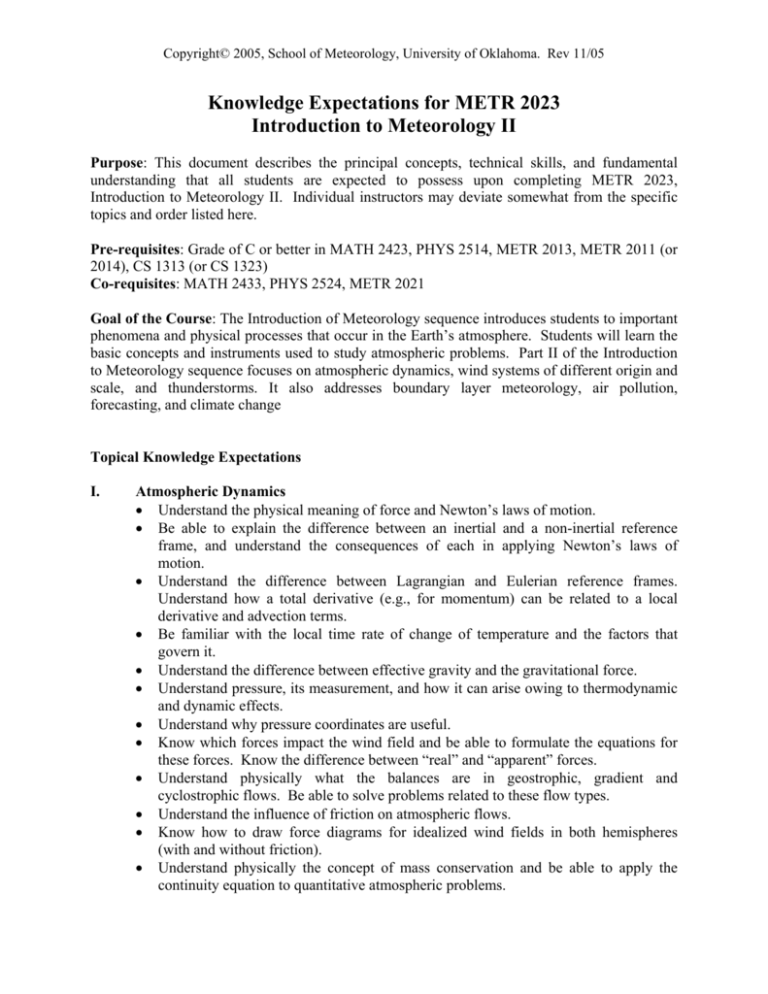
Copyright© 2005, School of Meteorology, University of Oklahoma. Rev 11/05 Knowledge Expectations for METR 2023 Introduction to Meteorology II Purpose: This document describes the principal concepts, technical skills, and fundamental understanding that all students are expected to possess upon completing METR 2023, Introduction to Meteorology II. Individual instructors may deviate somewhat from the specific topics and order listed here. Pre-requisites: Grade of C or better in MATH 2423, PHYS 2514, METR 2013, METR 2011 (or 2014), CS 1313 (or CS 1323) Co-requisites: MATH 2433, PHYS 2524, METR 2021 Goal of the Course: The Introduction of Meteorology sequence introduces students to important phenomena and physical processes that occur in the Earth’s atmosphere. Students will learn the basic concepts and instruments used to study atmospheric problems. Part II of the Introduction to Meteorology sequence focuses on atmospheric dynamics, wind systems of different origin and scale, and thunderstorms. It also addresses boundary layer meteorology, air pollution, forecasting, and climate change Topical Knowledge Expectations I. Atmospheric Dynamics • Understand the physical meaning of force and Newton’s laws of motion. • Be able to explain the difference between an inertial and a non-inertial reference frame, and understand the consequences of each in applying Newton’s laws of motion. • Understand the difference between Lagrangian and Eulerian reference frames. Understand how a total derivative (e.g., for momentum) can be related to a local derivative and advection terms. • Be familiar with the local time rate of change of temperature and the factors that govern it. • Understand the difference between effective gravity and the gravitational force. • Understand pressure, its measurement, and how it can arise owing to thermodynamic and dynamic effects. • Understand why pressure coordinates are useful. • Know which forces impact the wind field and be able to formulate the equations for these forces. Know the difference between “real” and “apparent” forces. • Understand physically what the balances are in geostrophic, gradient and cyclostrophic flows. Be able to solve problems related to these flow types. • Understand the influence of friction on atmospheric flows. • Know how to draw force diagrams for idealized wind fields in both hemispheres (with and without friction). • Understand physically the concept of mass conservation and be able to apply the continuity equation to quantitative atmospheric problems. Copyright© 2005, School of Meteorology, University of Oklahoma. Rev 11/05 • • • • • Be familiar with coordinate systems used in dynamic meteorology (e.g., natural coordinates, pressure coordinates). Understand the divergence of the wind field and the ways in which wind divergence arises in the atmosphere. Be able to compute the horizontal and three-dimensional divergence from wind data. Understand the basic concepts of vorticity and how it relates to circulation. Be able to compute the vertical vorticity from the equation that defines it. Understand the hydrostatic equation. Be able to use it quantitatively to solve problems related to the thermal structure of the atmosphere. Understand the thermal wind and how it relates to backing and veering winds as well as the structure of the jet stream. Be able to compute the thermal wind. II. Boundary layer and turbulence • Know the definition of the atmospheric boundary layer (ABL), and the different ABL types. • Understand the diurnal cycle of the ABL and basic mechanisms of the low-level jet formation. • Know the ABL structure under stable, neutral and unstable conditions, and typical profiles of meteorological variables throughout the ABL under these conditions. III. Air pollution • Have a basic understanding of the different types of atmospheric pollutants and their major sources and sinks. Know the difference between primary and secondary pollutants. • Understand the major processes that resulted in the formation of the ozone hole. • Understand how meteorological conditions influence air quality. • Know the classification of stack plumes and the key parameters that influence urban air quality. IV. Air Masses and Fronts • Understand what is an air mass. Describe the two weather elements (temperature and moisture) that are used to define air mass characteristics. • Understand the characteristics of air mass source regions, air mass movement, and air mass modification. • Describe the general characteristics of the cold front, warm front, stationary front, and occluded front. Understand how fronts relate to nearby synoptic fields. Understand the changes in weather elements that should be expected before, during, and following passage of cold, warm, and occluded fronts. Understand weather conditions associated with the stationary front. • Understand the three-dimensional nature of frontal boundaries. Be able to explain the concept of “stacking fronts.” Be able to draw and illustrate a cross-section of the atmosphere from surface to tropopause height between 30° and 60° N latitudes. Copyright© 2005, School of Meteorology, University of Oklahoma. Rev 11/05 V. Mid-latitude cyclones • Describe the polar front theory of mid-latitude cyclones. • Understand the general formation mechanisms for mid-latitude cyclones. • Understand the vertical structure of the atmosphere associated with mid-latitude cyclones. • Understand the relationship between the polar jet stream and the development of cyclones. • Be able to describe planetary waves of different temporal and spatial scales. • Understand the role of divergence and vorticity in development and strengthening of cyclones. VI. Thunderstorms and Tornadoes • Understand mechanisms by which air becomes supersaturated, namely, various forms of ascent, coupled with adiabatic expansion and cooling. • Understand how cumulus congestus clouds grow to become cumulonimbus clouds. Explain the processes of buoyancy, entrainment, detrainment, and the flow of air around thermals. • Understand the three stages of the air-mass thunderstorm lifecycle. • Understand how vertical wind shear modifies thunderstorms to create severe storms. Describe the mechanism most likely to account for the longevity of severe storms. • Understand storm features generally associated with severe thunderstorms, for example, the gust front. Describe the internal and near-storm motions that account for clouds associated with severe thunderstorms, for example, arcus, shelf, and roll clouds; mammatus clouds; and the anvil. • Describe how a family of thunderstorms can become a multicell or supercell storm. Explain the subtle differences between multicell and supercell storms. • Describe possible explanations for tornado formation. • Understand the characteristics of a tornado and be able to make a comparison in size, duration, wind speed, track, structure, and destruction potential between tornadoes and hurricanes. • Severe-weather preparedness. VII. General Circulation • Be able to discuss the general circulation of air on a non-rotating Earth that is uniformly covered with water and where the sun is directly overhead at the equator. • Be able to name and describe the idealized wind and surface pressure patterns over a rotating, uniformly water-covered Earth. • Be able to discuss how and why actual wind and surface pressure patterns on Earth differ from the idealized patterns. • Be able to discuss the formation and general characteristics of jet streams. • Be able to identify regions of cold currents and warm currents in the world’s oceans. • Be able to describe the various ways in which the atmosphere influences the oceans and the oceans influence the atmosphere. Copyright© 2005, School of Meteorology, University of Oklahoma. Rev 11/05 VIII. Tropical meteorology • Be able to give a definition of “tropics”. • Understand how tropical weather systems (e.g., easterly waves) differ from midlatitude systems. • Describe the formation and evolution of ENSO (El Nino-Southern Oscillation) events and its global impacts. • Know the necessary conditions for hurricane formation and decay. • Know the stages of tropical cyclone development. • Describe the characteristics and formation of waterspouts. IX. Forecasting • Be able to discuss these forecast techniques: Persistence, Trends (steady state), Climatology, and Numerical Weather Prediction (NWP). • Be able to identify weather features and patterns. • Knowledge of the various NWP techniques and their strengths and weaknesses. • Be able to discuss the concepts of predictability and chaos through the use of ensembles (sensitivity to initial conditions and nonlinearity effects). • Be knowledgeable in the methods of verification of both NWP guidance and forecasts. X. Climate Change • Know the difference between weather and climate. • Have a basic understanding of the history of the Earth’s climate variations. • Know the possible causes of climate change. • Understand the processes that play a role in climate change and be able to discuss the possible consequences of climate change. • Know about the capabilities and uncertainties of climate models.. Copyright© 2005, School of Meteorology, University of Oklahoma. Rev 11/05 Knowledge Expectations for METR 2021 General Meteorology Lab II Purpose: This document describes the principal concepts, technical skills, and fundamental understanding that all students are expected to possess upon completing METR 2021, General Meteorology Lab II. Pre-requisites: Grade of C or better in MATH 2423, PHYS 2514, METR 2013, METR 2011 (or 2014) Co-requisites: METR 2023 (normally taken concurrently) Goal of the Course: General Meteorology Lab II reinforces the theoretical concepts provided in the counterpart lecture course Introduction to Meteorology II (METR 2023), which introduces students to important phenomena and physical processes that occur in the Earth’s atmosphere. Through a series of laboratory exercises, students will learn the basic concepts and tools that are used to study atmospheric problems. Special emphasis will be placed on developing information technology and computational skills. The laboratory exercises target the topics covered in METR 2023 and, for more detail, please refer to the knowledge expectations for METR 2023.
